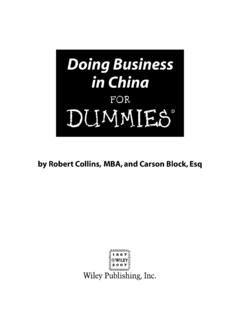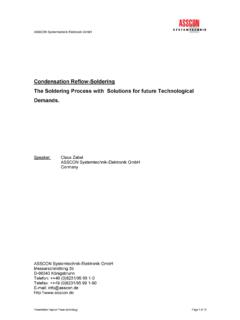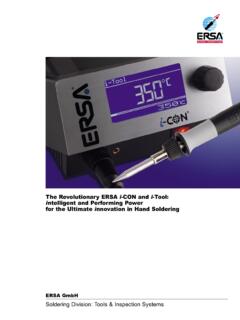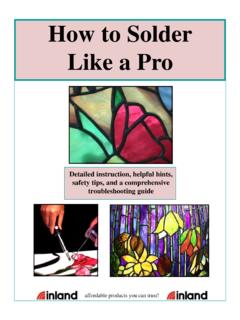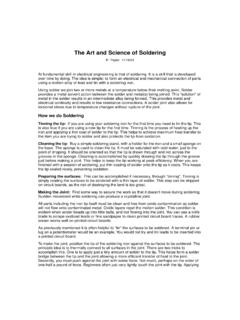Transcription of The Art Science of Soldering - The Eye
1 the art and Science of Soldering BY KARL T. THURBER, JR., WSFX/4 Learn to do it right, and save many later headaches There really is nothing all that difficult about Soldering . Still, most kits that are returned to the manufacturer, and a good number of homebrew projects that go awry, suffer from no more than poor Soldering . Although "cold" connections cause most Soldering prob-lems, short circuits, flux corrosion, heat damage to components, and the like also cause grief to the builder. 60 m December 1978 Soldering is a quick, simple, and inexpensive method of joining metals together. In fact, solder is one of mankind's oldest and most widely used alloys, being used by the ancient Romans and medieval architects.
2 Unfortunately, it is frequently misunderstood and even more frequently misused. So, before discussing how to solder properly and what equip-ment to use, let's first take a look at solder from a technical standpoint -the Science of Soldering . Some metals are just not solderable, at least in their natural states, not having an "affinity" for solder. Therefore, you need to first consider the metal to be soldered -some of the problem ones being magnesium, chromium, tanta-lum, silicon, and aluminum. This doesn't mean that it's impossible to solder to them; it's just a lot more difficult. Aluminum can be soldered, for example, if you use a special flux. To solder most of the difficult metals, they must be plated with a solderable metal; sometimes even solderable metals are plated in order to increase their shelf-life and make them even easier to work with.
3 Interestingly, non-metals such as ceramics and glass can be made solderable by a process called " firing," in which powdered silver, or other metal, is mixed with a borate, heated, and applied to the non-metallic surface, resulting in its becoming coated with the solderable metal. What is solder? Solder is simply a tin-lead fusible alloy that flows at a fairly low temperature, around 370 F (187 C). The low melting temperat ure allows connec-tions to be made easily with home-workshop tools - Soldering irons, guns, and pencils. Sometimes, small amounts of other metals such as antimony, bismuth, or silver are added to the tin-lead alloy to enhance the solder's charac-teristics or to make it suitable for some special purpose.
4 Because of its relatively low melting point, solder is used to form a metallic union or "joint" of two metals at a temperature well below their own melting points. To do the job right, the metals must be clean and free of all non-metallic matter, such as grease, or oxides which form on the surfaces of most metals. These impurities form an insulating barrier that prevents good metal-to-metal contact; excess o xides or other "junk" on the surfaces w i ll make good Soldering very diffi-cult, if not impossible. Solder is usually identified by its tin-to-lead composition. If you look at a package or roll of solder, you w ill probably f ind listed either the figures 40160, 50150, 60140, or 63137.
5 These numbers are the percentages of tin and lead, the tin percentage always being given first. As you will see later on, solder with a higher tin content melts at a lower temperature, which is usually desirable. Solder with more t in also costs more, because tin is an expensive metal. Let's examine more closely just what happens when you use that Soldering iron or gun. Since solder adheres by depending on a solvent or metallurgical action, the whole process breaks down if the solder itself is of poor quality, or of the wrong composition. When tin is added to lead, the melting point of the lead decreases along a known com-position-temperature line. Likewise, when lead is added to tin, the melting point of the tin is lowered along another such composition-temperature line.
6 The intersection of these two lines is known in the trade as the eutectic point and is shown graphically in Fig. 1. The so-cal led "eutectic alloy", made up of 63% tin and 37% lead, has a melting, or eutectic, temperature of 361 F (182 C). This composition is the standard for electronic pur-poses (being approximated by 60140 solder), and has a very sharp, pronounced, melting point. Other solder composi-tions w ill have a flexible or METAL COMPOS! TION (TIN CONT NT EXPRESSED FIRST) PORE LEAO 620 10190 20180 30/10 4016 0 50150 6014 0 70/3 0 80120 90110 600 $80 1--540 w :t $20 ~ i 500 ~ (/) 480 "' "' 460 0 440 420 400 380 360 ~ \ I\. \ ' '\. \ .. , \ ' \ \ ' \ SOLID METAL \ ' '\.
7 ALL LIQUID " 'r--. '!' !"\. PAST Y CONSISTENC Y "' / (LIOUIO 8 SOLID) "' / / ~ v PASTY CONSfSTCHCY l'\.c v"" SOLID METAL PURE TIN a / 450 I Fig. 1. As the percentage of ti n and lead c hanges, the melt ing point varies along a smooth line. The lowest melting-point temperature i s for a mixture of 63 per cent tin, 37 per cent lead (information from the booklet Solders and Soldering , prepared by the Solder Manufacturers Committee of the Lead Industries Ass ocia tion). Rosin core solder of 60140 compos ition is the most free flowing variety. The smaller diameters are partic ularly good for PC board work. High-quality solder is essential for good solder connections and trouble-free electronic circuits.
8 Plastic range running from the 361-degree eutectic tempera-ture up to the melting points of either pure lead (620 F, 326 C), or pure tin (450 F, 232 C). Another point that we haven't discussed is strength: a nice-looking solder connection does nothing for you if it won't take at least a little stress and strain. Since tin is a more active metallic " solvent" than lead, the quality of the joint is very closely related to its tin content. Taking a look at Fig. 2, you can see that solder with less than about 30 per cent tin content is inferior in its ability to take stress. The alloy "quality curve" reaches its peak with about 60 per cent tin alloy, which happens to closely correspond to the composition of the eutectic alloy we just described.
9 Solders with a 63137 or 60140 composition are the most free-flowing kinds and are particularly good for working on delicate printed circuits. Solder is most convenient to use in thin 16-or 18-gauge wire form; thicker solders are diffi-cult to control in terms of quantity and usually don't flow quickly enough. Be sure to buy only the best solder, and if it causes any problems, discard it and try another brand! How about fluxes? Three things are necessary for good Soldering : good December1978 II:1IJ 61 >-;z ~ 60 ~ "' 0 5 so "' "' ~ 4 0 ~ Vl Vi "' 0: JO Vl Vl "' g: Vl -~ ~--Jr\ / .. I \V I FRACTIONAL TIN CONTENT Fig. 2. The stress resistance of a sol dered connection is related to the per centage of tin in the alloy, and the point of best resistance is not far from the 63137 eutectic point shown in Fig.
10 1 (from "Solder and Soldering ," by Clifford L. Barber, Research Director, Kester Solder Company, in Popular Electronics, March, 1973, reprinted by permission). solder, enough heat, and the right flux. The solvent action that takes place between metals when you solder them can't properly take place if the metals are insulated from one another by a nonmetallic barrier or film, such as that formed by an oxide. The Soldering flux removes the oxide film (which is usually invisible to the eye) during Soldering , to allow good metal-to-metal contact and the metallurgical process to take place. The action of the flux is sometimes known as wetting the metal; after Soldering is complete, the oxides lie inert on the surface of the solder joint.





